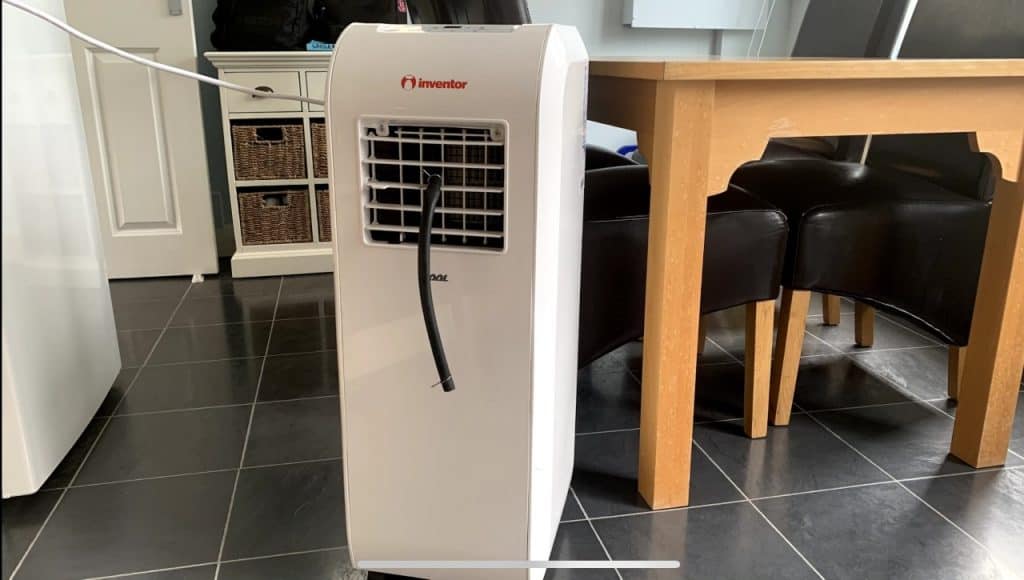When outside temperatures soar, this inevitably leads to the need for indoor cooling. Portable air conditioners are fantastic devices that offer a quick and relatively straightforward solution.
Portable air conditioner upstairs or downstairs – which is best?
The best location for the portable AC is wherever requires cooling the most, and is best suited to venting the hot air. The layout of the house will impact this decision.
This also depends on the specifics of the house in question.
In most cases, it’s unlikely that a portable air conditioner will be able to cool down two stories of a building simultaneously.
However, this may be possible if you have a corridor that links the two stories, or if the temperature of the floor and roof affects the overall temperature of the potential portable AC locations.
After reading this guide, you’ll know for certain whether upstairs or downstairs is the best place for your portable air conditioner.

Portable Air Conditioner – Upstairs or Downstairs?
If you’re using a portable air conditioner to cool your home, it’s important to place it in the most efficient location so that you get the full benefits it has to offer.
Positioning the air conditioner in the wrong place could lead to the cool air being wasted. Inefficient venting is also a common cause of limiting the effectiveness of portable air conditioners.
- For people who live in houses with two stories, deciding whether to put the portable AC upstairs or downstairs is something that must be considered carefully. Unfortunately, no answer applies to all cases, because many variables influence the results.
Firstly, putting the portable air conditioner upstairs offers several potential benefits.
Perhaps the most obvious is that hot air usually rises. This means that if the downstairs room gets hot, the heat will naturally make its way upwards, eventually causing the temperature of the upstairs room to rise.
If you cool down the upstairs room using a portable AC, this will inevitably cause the floorboards or other flooring materials to become colder. Depending on the materials and methods used to build your house, this could lead to the roof of the downstairs room cooling.
This cooling is less likely to occur if the floor and roof between the upstairs and downstairs are separated by dense structures that don’t easily change the temperature or allow air to be transferred.
If this is the case, then the question of whether your portable AC would be best positioned upstairs or downstairs becomes less important.
It’s also worth considering the ventilation process when deciding on which story to position the AC unit. As the device extracts hot air from the room, it must be vented out into a suitable place, which should be outside of the building.
Ideally, you should vent the hot air out of a window or even up a chimney, providing it is not in use.
If the upstairs has a suitable output for ventilation, it would make sense to put the portable AC there as the hot air will rise through the vent and out of the house without the risk of it being redirected inside.
Do You Need Two AC Units for a Two-Story House?
Cooling a two-story house is much more challenging than cooling a bungalow or other one-story building.
It may be tempting to try and save on costs by only using a single AC in a two-story house, but if you want to cool the entire building effectively it’s necessary to use another air conditioner.
Having one air conditioner either upstairs or downstairs in your house will mainly only cool the story that the device is located in. The other floor may be cooled slightly if you take specific measures, but the effect will be limited.
One common approach is to install separate ACs upstairs and downstairs in the house but to use them alternatively so that you’re not doubling the electricity use, and increasing the running cost.
The air conditioner downstairs can be turned on in the daytime when those rooms are prominently used. Then at nighttime, the downstairs AC can be turned off and the upstairs is turned on to cool the rooms while you are sleeping.
Temperature balance is a noteworthy benefit of using two separate ACs. Using a thermostat, you can set the individual temperatures of each floor to ensure that neither gets too warm during the times that they are used.
It’s not essential to have air conditioners in a two-story house, but it is certainly beneficial.
If this is not possible due to your budget or a lack of space, there are some steps you can take to
increase the impact of a single air conditioner in a house with two stories.
This video provides some useful information on how to get the best out of your portable AC.
Will a Portable AC Cool More Than One Room?
Although using a single portable air conditioner will not cool multiple rooms as effectively as using several, it is possible to lower the temperature of two rooms simultaneously.
First of all, the effectiveness will depend on the power of the portable air conditioner, and where it is positioned. More powerful devices are likely to cool a room quicker, and the cool air can then be directed into another room.
Smaller, less powerful devices will struggle to achieve this
If the rooms are next to each other, then simply leaving the door open between them will allow the cool air from the AC to enter both spaces.
It will take considerably longer for the temperature of both rooms to lower because the space has been increased, which means leaving the portable air conditioner on for longer than you would if you were only cooling a single room.
If the rooms are separated by a corridor or walkway, the cold air may be unable to enter the second room as quickly, which would make it quite pointless to attempt to cool to rooms with one portable air conditioner.
It’s worth experimenting with the location of the portable AC to figure out if that impacts its ability to cool multiple rooms. Placing it in the space between the two rooms may allow the cold air to be spread out more evenly between them.
The insulation used in your home and the thickness of the walls will also decide how effectively the portable air conditioner can cool down multiple rooms.
Is it OK to Leave a Portable Air Conditioner on All Day?
Leaving a portable air conditioner unit on all day won’t cause any problems. Like any other electrical device, it will cost you extra to continuously have the portable AC turned on for long periods.
Providing you clean the filters in the portable air conditioner and empty the condensation collector, there’s no reason that you can’t leave the device running all day to keep a room consistently cool.
The only risk is that using the portable AC continuously may result in the plug being overused, as the unit is likely to consume a fairly high amount of electricity. This may lead to a short if left unmonitored.
- The water tank which collects the condensation from the air could overflow if it is left on for long periods without being emptied. This will cause the water to spill out onto the floor, which is not ideal!
Inevitably, the more you use a portable air conditioner continuously, the quicker the components will wear out due to being under constant strain. Turning it off periodically allows the components to cool down and will improve the longevity of the unit, saving you the cost of regular repairs.
Leaving your portable air conditioner on all day will also rack up a huge electricity bill, due to the high-power designs of most units. The table below shows the average costs of using a portable AC compared to a central AC.
| Average Rating | Portable Air Conditioner | Central Air Conditioner |
| Watts | 2900 watts per hour | 3500 watts per hour |
| Cost | $0.38 per hour | $0.45 per hour |
Using a timer plug is an effective way to manage the temperature of a room by triggering the portable air conditioner to come on throughout the day. Some have an inbuilt timer that performs the same function.
Related Questions
What happens if you don’t drain a portable AC?
If you do not empty the water that the portable air conditioner collects, this will likely cause it to shut off. Most ACs have s sensor so that they turn off before overflowing to avoid damage.
Does portable air conditioner overheat?
Like all electrical devices, portable air conditioners can overheat especially when used continuously. The most common cause for overheating is the compressor, which heats up due to poor ventilation.
Do portable air conditioners need a window?
Windows are by far the best place to vent the hot air from a portable air conditioner. Other alternatives include an unused chimney or an opening in the wall, but windows should be the first choice. Take a look at our article on venting your AC. You can find it here.





